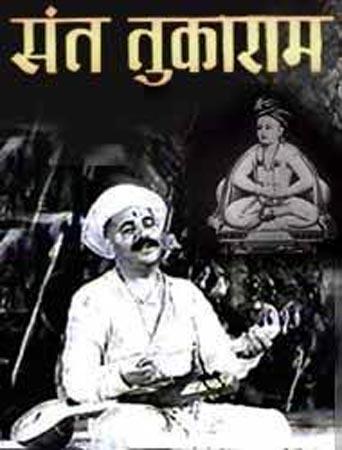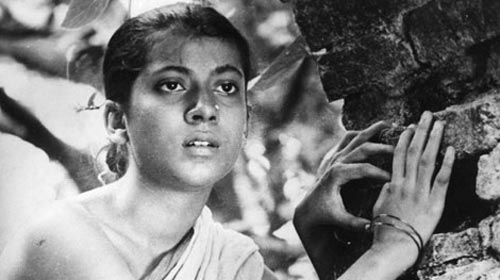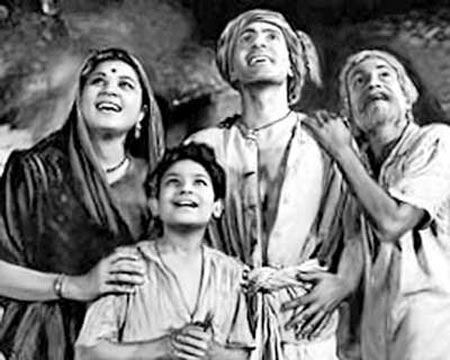Veenu Sandhu in Mumbai
As Indian cinema celebrates its centenary year, filmmaker Shyam Benegal lists his favourite five films of all time.
Sant Tukaram (1936)
Directed by Vishnupant Govind Damle and Sheikh Fattelal
Language: Marathi
This film is not necessarily a work of cinematic craftsmanship. A somewhat primitively made film, it was an extraordinary achievement. Sant Tukaram (by Prabhat Film Company) was so culturally true. It was homegrown, true in all the essentials, it was organic. If you looked at the setting, the people in it, you could not mistake it for being set in any other place but Maharashtra. There are extraordinary dialogues which bring out the relationship between Tukaram and his wife. I don't know if this film will appeal to the masses today because films become dated very fast.
A film is made in the idiom of its time. And idioms change. Like a Victorian novel, when you read its flowery language today, you think, "How quaint." But if you go beyond the quaintness and look at the quality, then you understand its worth.
Sant Tukaram (a classic based on the life of one of Maharashtra's most popular 17th century saint poets) was a landmark in Indian cinema and the first Indian film to win an award at an international film festival — the Golden Lion Award at the Venice Festival. (Released at Central Cinema, Bombay, on December 12, 1936, the film went to on to break all records and ran continuously for 57 weeks. Six million people from Maharashtra alone watched it over this period.
Interestingly, the Venice film festival participation certificate of Sant Tukaram was lost and was found years later in a roadside dustbin on the Law College road in Pune. It now lies with the National Film Archive of India).
Pather Panchali (1955)
Image: A scene from Pather PanchaliWritten and Directed by Satyajit Ray
Language: Bengali
Satyajit Ray is responsible for changing the nature of film discourse. He went totally against prevailing cinema culture and created a new cinematic language. Pather Panchali ("Song of the Little Road", Ray's directorial debut and the first of the Apu triology) is a remarkable achievement in terms of cinematic experience.
The emotional power and strength of that film grips you. It's not that it is a very sentimental film, though it has every element that could make it that. Set in the early 20th century in a remote village in Bengal, this story of a poor Brahmin family and the early experiences of its youngest member, Apu, is pure cinema.
Taking a mostly amateur cast (and an inexperienced crew), Ray went on to make remarkable, realistic cinema. It's a powerful narrative that takes its time to build up. Ray did not rush this film (he shot it over three years as and when he could arrange the funds).
The life of the family, Apu's emergence as his own person after the death of his sister, the powerful emotions that play out with elegance without giving in to overt sentimentality, the pace of the film which is always in sync with rural Bengal and its landscape — it all comes together as pure art.
Pyaasa (1957)
Image: A scene from PyaasaProduced and Directed by Guru Dutt
Language: Hindi
Pyaasa was a true achievement by Guru Dutt and had extraordinary lyrics by Sahir Ludhianvi. Guru Dutt had made other films too, but this one came out of his own deep personal feeling. It was the first truly personal film made by anyone in Indian cinema. There is sometimes a toss-up between Pyaasa and Kaagaz Ke Phool (1959). But for me, it has always been Pyaasa over Kaagaz Ke Phool.
I feel Kaagaz Ke Phool was very subjectively told, where there is a lot of self pity, where he is the victim. Pyaasa's cinematography was also exceptional.
The film was shot by V K Murthy, who was the finest cameraman of his time. He also shot Guru Dutt's Kaagaz Ke Phool and Sahib Bibi Aur Ghulam. Murthy, who recently won the Dada Saheb Phalke Award, brought out that stark magic of black and white. The film's music (composer S D Burman, lyricist Sahir Ludhianvi, and singers Geeta Dutt and Mohammed Rafi) was unparalleled. (Pyaasa has been rated as one of the 100 best films by Time magazine. On Valentine's Day 2011, the magazine also declared it the top 10 romantic movies of all time).
Anantharam (1987) and Jagte Raho (1956)
Image: Left: A scene from Anantharam. Right: Raj Kapoor in Jagte RahoFilm: Anantharam
Directed by Adoor Gopalakrishnan
Language: Malayalam
Film: Jagte Raho
Directed by Amit Maitra and Sombhu Mitr
Language: Hindi
There is a tie between these. I cannot choose one over the other. Adoor Gopalakrishnan's Anantharam is a beautiful, well-told story, both in terms of direction and performance. It's very moving. It's a story about a person with bipolar disorder and questions the very premise of bipolar disorder. The film passes no judgments and is ambivalent and sophisticated in its telling. Gopalakrishnan brings a completely new narrative style with this film.
The protagonist (Ajayan) narrates a story twice over to explain himself and his state of mind — once about how he came to have what some would call an irrational state of mind and then the story of his conflicts as a young man and of his sister-in-law. Somehow, somewhere, Gopalakrishnan brings these two stories together as only a master in the art of cinematic storytelling can. If you think about it, it happens even to normal people. After all, can a person look at the world from any other perspective but his own?
Then there is Jagte Raho directed by Sombhu Mitra, one of the most famous theatre actors from West Bengal. Along with the outstanding Raj Kapoor (who plays the lead role), he creates a gripping masterpiece. This story of one night in the city is packed with stories, each marvelously brought out. (Raj Kapoor plays a villager who comes to the city in search of a better life but finds himself exposed to the unsavoury nightly goings-on of "respectable" middle-class dwellers of a
Do Beegha Zamin (1953)
Image: A scene from Do Beegha ZaminDirected by Bimal Roy
Language: Hindi
In the last 100 years, Indian cinema has seen several marvelous films. It is very difficult to choose one over the other another should I choose from recent films or go back into the past? And also, why am I choosing one over the other? But if there is one film which simply has to be here, it is Do Beegha Zamin.
Here, Bimal Roy took the camera out of the studio and to the streets and fields, shooting on location. Before this you didn't quite get to see the real world. It was mainly make-believe, extraordinarily done but created in a particular place.
Bimal Roy introduced realism with this movie. He showed that you didn't need to follow the same conventions. And Balraj Sahni, with his exceptional performance, did the rest. (The actor rehearsed for the role by pulling a rickshaw on the streets of Calcutta and spent time with rickshaw-pullers).
This was an early example of parallel cinema. (The story of a farmer's desperate attempt to save his meagre land from being consumed by a proposed mill was the first Indian film to win the International Prize at the Cannes Film Festival). Also striking was the music composed by Salil Chowdhury.







Comment
article